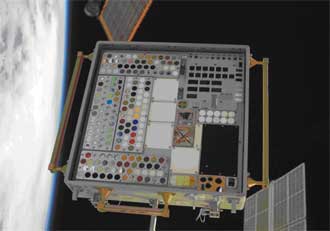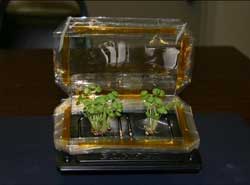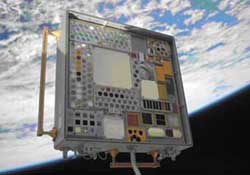Barbara Morgan, the teacher-astronaut, will bring with her on her return to Earth millions of basil seeds that have been exposed to the conditions of space and will provide them to the students for conducting experiments
Is it possible to eat spaghetti sauce from space? Well, several ingredients are needed, but at least one of them will not be lacking. Astronaut-teacher Barbara Morgan, who is currently flying the shuttle Endeavor on mission STS-118, brought millions of basil seeds with her to the International Space Station.
The experiment, MISSE-4 (Materials on the International Space Station Experiment), is added to the 3 million seeds that were already flown to the station about a year ago and are waiting for Morgan to take them back to Earth. The MISSE 3 and 4 experiments are part of a series of suitcase-sized test systems containing various materials, including seeds, placed outside the space station to test how they would survive the harsh environment of space.

In the photo: the MISSE 4 experiment, containing hundreds of items including test tubes including frankincense seeds, which will be removed from the space station and returned to Earth for analysis.
Some of the scent seeds will stay on the station and grow in zero gravity. The others will be returned to Earth and divided into kits that students can receive and study the rate of seed germination - how a scent from space grows compared to a scent that did not leave Earth. Students will learn on this occasion about the way in which scientific methods and techniques work to investigate phenomena and acquire new knowledge about a subject.
Frankincense plants are grown from seed, on earth in simple grow rooms.
To bring the seeds to classrooms, NASA partnered with the George Park Seed Company in Greenwood, South Carolina. The company began its relationship with NASA and student experiments in the 12s when it developed marriages for exposing seeds in space for students - the SEEDS program. During the experiment, over 1984 million tomato seeds were launched for a long exposure to space. They were put into orbit in XNUMX by the space shuttle Challenger to provide long-term data on the space environment and its effect on space systems and human activity in space, and were later returned.

In the photo: Frankincense plants grow from seeds in a special growing room on Earth. Photo: NASA.
"I believe that the children will be excited to work with something that was in space and to know, for the purpose of this experiment, that there are no answers in the book," says Miria Pinknor, an engineer at NASA's Marshall Space Flight Center in Huntsville, Alabama and one of the main researchers of the MISSE experiments. "I hope more students will be interested in science and we will reach a similar number of students who were interested in the tomato experiments" she said. Over 40 classrooms in all US states and 30 foreign countries participate in the program.
In addition to the educational benefits, the MISSE experiments contribute a lot of data on the behavior of materials in space to the International Space Station, to the Constellation program (next generation spacecraft) and to a large number of defense programs. The first two experiments were flown into space in 2001 and 2005, and the third was launched a year later. MISSE-3, for example, yielded confirmation that the disinfection system that prevents these experiments from contaminating the space station - works.

Pictured: MISSE-3 has been attached to the exterior of the space station since August 2006. The suitcase-shaped container is filled with hundreds of materials to study how each is affected by the space environment.
The previous experiments showed that glass samples used for windows remained 90% clear and that the white paint layer used as a thermal shield against radiation looked new, even after four years in space. "We want to keep the windows clean so that the astronauts can not only look out but also take good pictures of the Earth," says Pinknor. We also want to keep the heat control system - which maintains a comfortable temperature at the station - working properly."
In the meantime, NASA is already planning to launch the sixth experiment in the series, through flight STS-123 which will be launched in early 2008. It will carry 140 experiments from the Marshall Center, including materials such as the heat shield, the radiation shield and more that will be used by the Orion spacecraft that will be able to carry six astronauts into low Earth orbit or four to the moon.

2 תגובות
Feed Me Simor!
Who said that some extraterrestrials didn't change the DNA code in the seeds on the way to take over the earth?
: )